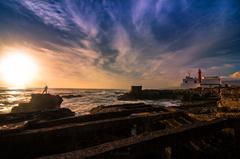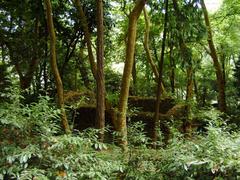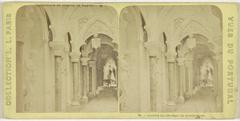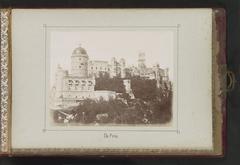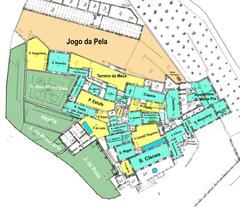Farol do Cabo da Roca Visiting Hours, Tickets, and Travel Tips
Date: 19/07/2024
Introduction
Farol do Cabo da Roca, located at the westernmost point of mainland Europe in Sintra, Portugal, is not only a beacon of maritime history but also a mesmerizing destination for travelers. Known historically as ‘Promontorium Magnum’ by the Romans and later as ‘Cabo da Roca’ by the Portuguese, this iconic lighthouse has played a crucial role in navigation during the Age of Discovery. Constructed in 1772 under King José I of Portugal, the lighthouse is one of the oldest in the country, marking its significance in maritime safety (Visit Portugal). In this comprehensive guide, we will explore the rich history, architectural marvels, technological advancements, and cultural significance of Farol do Cabo da Roca. Additionally, we will provide practical visitor information, including visiting hours, ticket prices, travel tips, and nearby attractions to ensure a memorable experience at this historical site.
Table of Contents
- Introduction
- Early History and Strategic Importance
- Construction of the Lighthouse
- Architectural Design
- Technological Advancements
- Role During World War II
- Preservation and Cultural Significance
- Modern-Day Operations
- Visitor Experience
- FAQ Section
- Conclusion
Discovering Farol do Cabo da Roca - History, Visiting Hours, and Tips
Early History and Strategic Importance
Farol do Cabo da Roca, situated at Cabo da Roca, was first documented by the Romans as “Promontorium Magnum” and later by the Portuguese as “Cabo da Roca” (Visit Portugal). Its strategic location made it a crucial navigational point for explorers during the 15th and 16th centuries, serving as a landmark for ships returning from the New World and the East Indies.
Construction of the Lighthouse
The construction of Farol do Cabo da Roca began in 1758 under the reign of King José I of Portugal. The project was part of a broader initiative to improve maritime safety along the Portuguese coast, notorious for shipwrecks due to its rugged terrain and unpredictable weather conditions. The lighthouse was completed in 1772, making it one of the oldest lighthouses in Portugal (Faróis de Portugal).
Architectural Design
The original structure of Farol do Cabo da Roca was a simple, cylindrical tower made of stone, standing 22 meters tall. It was equipped with an oil lamp that emitted a fixed white light, visible from a distance of approximately 20 nautical miles. Over the years, the lighthouse underwent several renovations to enhance its functionality and durability. In 1843, a new lantern room was installed, and the light source was upgraded to a Fresnel lens, significantly improving its range and intensity (Direção-Geral do Património Cultural).
Technological Advancements
The 20th century brought significant technological advancements to Farol do Cabo da Roca. In 1946, the lighthouse was electrified, replacing the oil lamp with an electric light source. This upgrade not only increased the brightness of the light but also reduced the need for constant maintenance. In 1980, the lighthouse was automated, allowing it to operate without the need for a full-time keeper. The automation process included the installation of a radar system and a radio beacon, further enhancing its navigational capabilities (Autoridade Marítima Nacional).
Role During World War II
During World War II, Farol do Cabo da Roca played a vital role in maritime navigation and coastal defense. The lighthouse was equipped with additional signaling equipment to assist Allied ships navigating the treacherous waters of the Atlantic Ocean. Despite the war’s challenges, the lighthouse continued to operate, providing a crucial service to both military and civilian vessels (História de Portugal).
Preservation and Cultural Significance
In recognition of its historical and cultural significance, Farol do Cabo da Roca was classified as a National Monument in 1978. This designation helped ensure the preservation of the lighthouse and its surrounding area, which includes a visitor center and a scenic viewpoint overlooking the Atlantic Ocean. The site attracts thousands of tourists each year, drawn by its breathtaking views and historical importance (Património Cultural).
Modern-Day Operations
Today, Farol do Cabo da Roca is managed by the Portuguese Navy, which oversees its maintenance and operation. The lighthouse remains an active navigational aid, guiding ships along the Portuguese coast with its powerful light, which has a range of 26 nautical miles. In addition to its practical function, the lighthouse serves as a symbol of Portugal’s maritime heritage and its enduring connection to the sea (Marinha Portuguesa).
Visitor Experience
Visiting Hours, Tickets, and Travel Tips
Farol do Cabo da Roca is open to visitors from 10:00 AM to 6:00 PM daily. The entrance fee is €5 for adults, €3 for seniors, and free for children under 12. It is recommended to arrive early to avoid crowds and ensure a leisurely visit. The site is accessible by car, with parking available nearby, or by public transportation from Sintra. Nearby attractions include the picturesque town of Sintra, known for its palaces and gardens, and the beautiful Praia da Adraga beach (Turismo de Portugal).
Special Events and Guided Tours
Farol do Cabo da Roca occasionally hosts special events such as night tours and cultural performances. Guided tours are available for groups, providing a more in-depth exploration of the lighthouse’s history and significance. These tours must be booked in advance through the official website or visitor center.
Photo Spots
The lighthouse and its surrounding cliffs offer numerous photographic opportunities. Some of the best spots include the viewpoint near the visitor center, the rugged coastline, and the lighthouse itself, especially at sunset when the sky is painted with vibrant colors.
FAQ Section
Q: What are the visiting hours for Farol do Cabo da Roca? A: The lighthouse is open from 10:00 AM to 6:00 PM daily.
Q: How much are the tickets for Farol do Cabo da Roca? A: Tickets are €5 for adults, €3 for seniors, and free for children under 12.
Q: How do I get to Farol do Cabo da Roca? A: The site is accessible by car with parking available nearby or by public transportation from Sintra.
Q: Are there guided tours available? A: Yes, guided tours are available for groups and must be booked in advance.
Conclusion
Farol do Cabo da Roca stands as a testament to Portugal’s rich maritime history and its ongoing commitment to maritime safety. From its early days as a navigational landmark to its modern role as a cultural and historical site, the lighthouse continues to captivate visitors with its storied past and stunning location. Managed by the Portuguese Navy, the lighthouse remains an active navigational aid, guiding ships along the Portuguese coast. Visitors can explore the lighthouse grounds, enjoy guided tours, and take in the breathtaking views of the Atlantic Ocean. Whether you’re interested in history, architecture, or simply looking for a scenic spot to visit, Farol do Cabo da Roca offers a unique and enriching experience (Turismo de Portugal). For those planning a visit, remember to check the visiting hours, arrive early to avoid crowds, and take advantage of the nearby attractions such as the picturesque town of Sintra and the beautiful Praia da Adraga beach.

